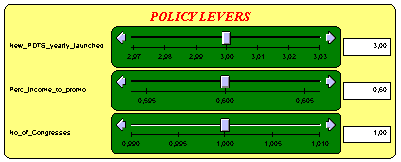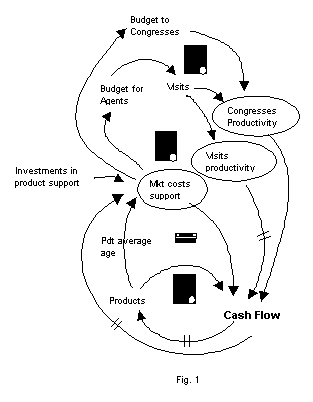
|
|
|
ABSTRACT
The paper will discuss the nature of a prototype model developed to demonstrate the strengths of S.D. approach to support marketing management decisions in a big pharmaceutical company.
A dynamic model is sketched and discussed in order to understand feedback loops related to the use of different promotion media; special attention is devoted to the following aspects:
Different strategies are evaluated, through simulation runs and results are commented in order to better understand managerial processes.
Developing such learning environments will allow to induce marketing managers to adopt S.D. modeling as a key component of their current decision support systems, which are now mainly based on statistical approach.
PHARMACEUTICAL ENVIRONMENT
A relevant characteristic of pharmaceutical market - at least in Italy - is that it is not permitted to producers (commercial agents) to contact directly the final consumer (patients) through promotional actions. In fact in this environment the consumer is different from who decides (the doctor) on choosing the product. So company scientific information and promotional effort are mainly oriented to gain doctor's "faith" and consequently stimulate him/her to prescribe, when it is necessary, that type of medicine instead of one similar in characteristics and effects belonging to another company. This goal is normally achieved through personal contacts with doctors, their involvement in congresses (free travels), gadgets, advertising, etc.
FOCUS OF THE MODEL
The marketing function has to manage a given annual budget in order to achieve a target sales "level". The sales manager handles a set of promotional levers and his/her main problem is to assess and compare their relevance according to alternative scenarios. The goal of our "pilot" model is to show the strength of system dynamics approach to support the management learning and decision making. In figure 1 the main causal loop diagram of whole process is sketched.
| There is a total marketing support cost which is forwarded mainly to personnel (budget to sales agents) and to organize and involve (invite) doctors in congresses (budget to congresses). The more time is dedicated in visiting doctors the higher both congress and visit productivity will be, so (after a delay) higher will be sales as well as cash flows. Higher cash flows will be likely to foster a new positive loop as they allow to launch (after another delay) new products (medicines). On the other hand launching of new products also implies a decreasing of product avrage age which causes more investments (with delay), higher marketing support costs and so cash flow decreases. |  |
The model supports decision makers to understand the above dynamic process analysis and possibly to better manage product investments.
THE MODEL
The pharmaceutical model is mainly developed through three interconnected subsystems:
Product management Sub-System
| The concept of "equivalent products" has been introduced, in the model, to smooth new products over a time period in order to avoid "peaks" in product portfolio management. Average product age drives promotion activities: while in the initial stages of medicine life-cycle a strong promotional effort is needed, later in time such an effort is reduced (also because the knowledge by doctor on the product increases). | 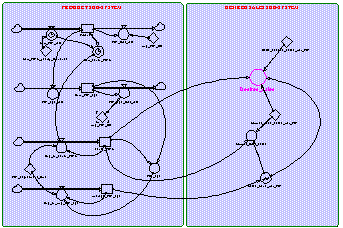
|
Desired product sales, deduced through the number of prescriptions made by doctor to his/her patients (indirectly and approximately defined through the number of medicine sold by all pharmacies in the area of doctor's place) is calculated as a sum of two components:
A share of promotional effort is devoted to maintain standard sales "level", which also depends on word-of-mouth, product quality and existing marketing demand.
Sales agent Sub-System
| The number of doctors to be visited is supposed to depend on product portfolio scope. An increasing number of products implies the entrance in new market segments which will involve a higher number of doctors in the company's potential "medicine prescribers". In the launch stage of medicine life-cycle a bigger promotional effort is required: a lower | 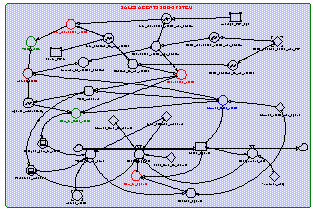 Fig. 3 Fig. 3 |
average product age, will imply a higher number of visits required to guarantee proper pharmaceutical scientific information. Required number of visits is also affected by "delta desired sales", i.e. extra sales over normal achievable "level" the company desires. If the existing number of sales agents, even under pressure, is not sufficient to visit the whole number of doctors at the needed frequency, the company hires new agents which become productive after a training period. This reduces the gap between actual and requested visits.
Congresses Sub-System
| According to the budget, the company promotes congresses, generally to launch new products. Congress costs consist of a fixed share and a variable one, due to the number of invited doctors (free travel). The combination of these costs represents the company's effort in congress promotion. | 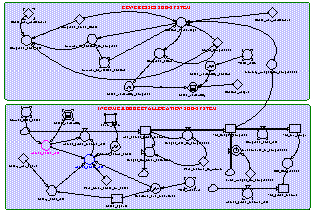
|
To economically evaluate the consequence of different strategies related to the above subsystems and to foresee company's results, a "first attempt" model to support budgeting is sketched (see figure 4).
RESULTS
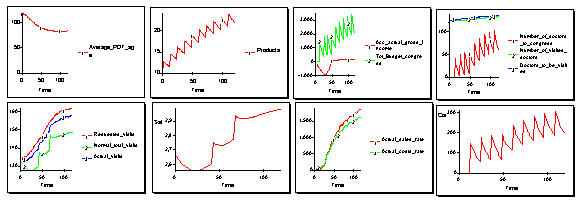
The model allows one to simulate product dynamics over a ten years (120 months) time horizon. The more products are launched the lower will be average products age and higher product sales support (agents and visits to doctors) will be needed.
In the simulation run, whose main results are summarized in fig. 5, it is supposed that three products are launched at the beginning of each year and 60% of current income (difference between sales revenues and production, distribution, sales agents costs) is reinvested in congress activities. In case enough budget is available for such activities, a congress each month on average is organized. Budget for congress is allocated in two parts: a) fixed organization costs; b) variable costs per participant. The results confirm that the higher is the number of visited doctors (who already know the company) by sales agents and budget for congresses, the more will be doctors invited to congresses and, consequently, higher will be congress productivity (i.e. sales). A reasonable product support investment by sales agents will allow higher sales which, reinvested in new promotion activities, will enhance the virtuous positive loop leading to growth.
